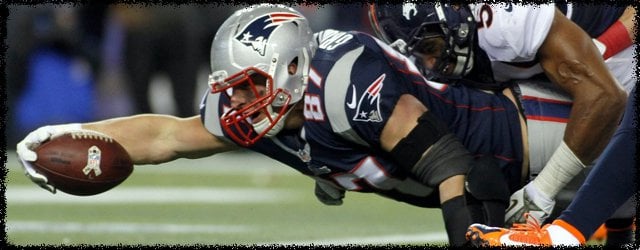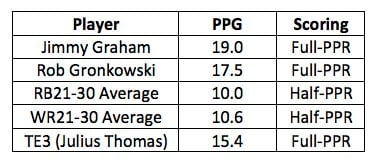The DLF Mailbag

Welcome to the latest edition of the weekly mailbag.
Send me your questions using the DLF Mailbag Form and I’ll include the best in future articles. Remember the guidelines to have the best chance at seeing your question get posted:
1.) Dynasty questions only, no start/sit questions
2.) Help me help you by providing sufficient information about your league (e.g. line-up requirements/PPR or non-PPR/etc.), and include your first name and where you’re from.
3.) Your chance of getting your question answered is inversely proportional to the length of the question.
Let’s get to it!
1. I have pick 1.06 in a ten-team dynasty start-up. Would I be crazy to take Jimmy Graham with my first pick and then on the way back take someone like Rob Gronkowski? This league is half-PPR for receivers and running backs and full PPR for tight ends, and there is also a bonus for long touchdowns. We start two running backs, two receivers, a tight end and a FLEX. – Pat in NJ
This is seemingly one of those scenarios where you can pick your favorite uplifting catchphrase. “Chance favors the prepared mind” is certainly apt, and somewhat fits your draft plan. Instead though, I’d choose to use an old Latin proverb – “fortune favors the bold.”
Though a TE-TE draft opening is certainly unorthodox, given your league parameters I think it’s the correct move. In fact, consider the following table:

The numbers above relate the point-per-game totals of both Jimmy Graham and Rob Gronkowski to the FLEX-caliber players in your league, as well as the next best per-game option at tight end (Julius Thomas). As can be seen, your pseudo TE-premium scoring places a huge emphasis on elite options at the position. As such, the ability to start two such players not only gives you the ability to enhance your starting lineup, but also detracts from your opponents.
The “lesser” of the two options, Gronkowski, scored at a rate 75% greater than the half-PPR RB21-30 range, and 65% more than the receivers in the same grouping. Moreover, rostering both studs means, at a minimum, your advantage at the tight end position would’ve 14% greater than that of the owner of the TE3 (Thomas). While you’ll still need to make solid picks in the following rounds to fill out your starting lineup, the totality of these advantages causes me to whole-heartedly support this strategy.
2. So my league has a FLEX spot where you must start a rookie. How would you re-rank the top-ten rookies knowing first year playing time is essential, and also considering I want to contend for a title? – Brett in TX
Instead of completely re-ranking the rookies, I’ll instead touch on a few players whose values increase and decrease due to your league rules. Let’s start with the risers:
Brandin Cooks – Already viewed as a surefire top three or four selection, Cooks should go even higher considered the unsettled Saints pecking order behind Graham and Marques Colston. With Lance Moore and Darren Sproles departed, Cooks could see a reasonable amount of work in one of the league’s best offenses. I wouldn’t hesitate to take him at pick 1.02.
Kelvin Benjamin – Depending on how much stock you put into preseason activity, Benjamin’s stock is already on the rise. Looking like Cam Newton’s top target, Benjamin could very well be this year’s version of Keenan Allen. You could make a case for taking Benjamin at 1.04.
Carlos Hyde and Jeremy Hill – Hyde appears to be the clear backup to the venerable Frank Gore in a run-based offense. Hill, meanwhile, seems likely to “split” time with sophomore Gio Bernard. In this format Hyde could go as early as pick 1.05, and Hill at pick 1.10.
And now for the fallers…
Sammy Watkins – I’d likely still take Watkins at pick 1.01, but it’s hard to ignore his moribund situation. Quarterback EJ Manuel already has the aroma of “bust” on him, and could very well miss the ocean if he was throwing a football from his boat. A legit case could be made for Watkins falling to pick 1.02.
Bishop Sankey – Once again, you need to take this with a big old preseason-flavored grain of salt. However, if coach Ken Whisenhunt stays true to his usage Sankey is no greater than the third man through. He could fall to pick 1.07-1.08.
The ancillary receivers and tight ends – Numerous rookie wide receivers were drafted with the hope they’d contribute later. Names such as Davante Adams, Allen Robinson, Donte Moncrief and Odell Beckham could all be dropped down a few notches. Rookie tight ends also rarely contribute in any meaningful way, and I’d rather wait until the late second round for a player like Jace Amaro than overspend on Detroit’s Eric Ebron.
3. In a 12-team, non-PPR league which side wins this trade: four years of Mike Evans or four years of Carlos Hyde plus five years of Allen Robinson? We start two running backs and three receivers. – Chad in IL
[inlinead]In a non-PPR setting, touchdowns move to the critical forefront as a defining characteristic of winning squads. To that point, in 2013 10 of the top 12 non-PPR running backs had at least 10 total scores, while the average touchdown total for the top 12 receivers stood at 9.9, with 10 players recording at least eight touchdowns. Simply put, crossing the end zone one additional time can quite legitimately determine the difference between winning and losing on a weekly basis.
Though touchdowns are tough to predict, using prior team data can provide some insight into future production. To that end, since coach Jim Harbaugh joined San Francisco in 2011, starting running back Frank Gore has averaged 0.54 touchdowns per game. With Hyde as the next in line, it’s entirely reasonable to expect similar production in the future.
Moving to the receivers, we can attempt to rely on collegiate data. At Penn State, Robinson scored one touchdown per every 10.4 receptions, but perhaps more importantly sequestered 38% of the team’s receiving touchdowns over the past two years. Evans, meanwhile, scored once per ever 8.9 collegiate receptions at Texas A&M, but “only” corralled 25% of the team’s scores through the air. Evans is the better player to be sure, but in this setting it’s fair to say Robinson gets a boost.
As such I prefer the Hyde side. Running backs are inarguably the most important position in a non-PPR setting, and Hyde looks primed to be a good one. This easily mitigates the drop-off from Evans to Robinson in my opinion, and should yield you two quality future starters.
4. The Packers resigned Jordy Nelson but have yet to resign Randall Cobb. Do you think they will resign Cobb or is it time to sell him at a higher value? – Kevin in MN
According to the August ADP Packers receiver Randall Cobb is being viewed as the overall PPR WR9, as an early second round selection. This is certainly understandable, as since the 2012 season Cobb’s average weekly line stands at 5.3/66.0/0.57, to go with an additional 210 rushing yards. With one of the best in the league, Aaron Rodgers, under center, it stands to reason Cobb’s ascent should continue in 2014.
With that said, this upcoming season could mark Cobb’s last as a cheesehead. Though positional cohort Jordy Nelson was re-signed this off-season, GM Ted Thompson is known for not overspending to keep his assets in Green Bay. Previously, former Packers stud Greg Jennings received a three-year contract worth “only” $8.8 million per year, but he also had a more extensive track record than Cobb – should the Packers fail to extend Cobb prior to the season, and if he has a strong season, he could very well price himself right out of town.
Continuing, bracing for this potential likelihood the Packers spent three 2014 draft picks on wide receivers – Davante Adams (2nd), Jared Abbrederis (5th) and Jeff Janis (7th). As Thompson isn’t known to waste draft capital, especially in the early rounds, this could be viewed as a harbinger for the Packers roster status come 2015. While this can only be viewed as circumstantial evidence at best, it’s nevertheless more cause for concern for Cobb’s future outlook.
As such I won’t fault you if you want to (arguably) sell high on Cobb. There are other receivers in his range who offer more stability (Keenan Allen, Antonio Brown and Brandon Marshall), as well as those whose upside is arguably higher (Michael Floyd, Cordarrelle Patterson and Sammy Watkins). If you’re worried about Cobb’s future, you’d do well to make a deal based upon snagging one of the players mentioned above.
5. I have the second pick in a 12-team PPR league with eight keepers. My keepers are Andrew Luck, Alfred Morris, Le’Veon Bell, Zac Stacy, TY Hilton, AJ Green, Michael Crabtree and Josh Gordon. I’m old school on building running back depth and am looking at Bishop Sankey or Toby Gerhart with the second overall pick, but am wondering if I should take a look at Sammy Watkins, Eric Ebron or even Carlos Hyde instead? – Matt in NC
Though I can appreciate your desire to maintain your preferred strategy, I think you need to go where the value is. Despite a rocky preseason, Buffalo rookie Sammy Watkins is popularly viewed as 2014’s top rookie, and as such should command the most value on the open market. If you’re truly serious about building around your ball carriers, I’d draft Watkins and look to cash in via trade.
[ad5]
- Dynasty Fantasy Football Mailbag: Is Kendre Miller Valued Unfairly? - April 17, 2024
- Forgotten Dynasty Veterans: Bottom Tier - April 9, 2024
- Dynasty Fantasy Football Mailbag: How Much Should You Factor in Off-Field Issues? - April 9, 2024


































































